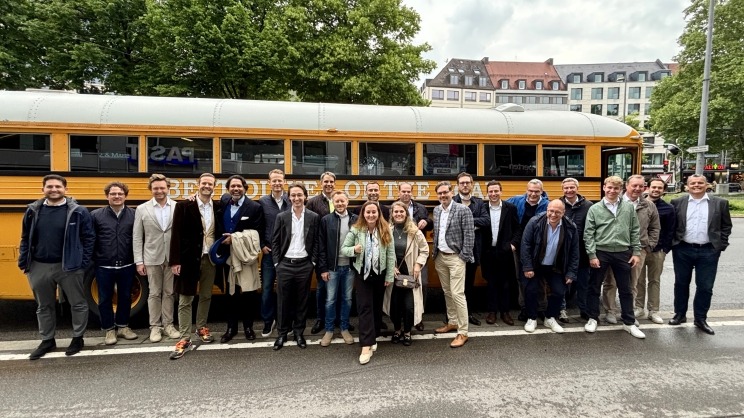Alumni Spotlight: Jascha Kaykas-Wolff

Jascha Kaykas-Wolff, formerly a Director in A&M’s Corporate Performance Improvement practice from 2007-2008, is now the Chief Marketing Officer (CMO) at Mozilla. Prior to that, he worked at Microsoft as a Group Manager of User Experience and a Business Development Manager at Yahoo. Mozilla is a global nonprofit and community of technologists, thinkers and builders working together to keep the Internet alive and accessible.
Mr. Kaykas-Wolff noted that his A&M experience was instrumental in leading him to where he is now in his professional career. In today’s increasingly digital climate, especially considering the discussion of net-neutrality, how the Internet is being maintained is a more relevant topic than ever. From a product perspective, Mozilla is making significant moves in the market, as evidenced by the release of its new Firefox browser in November.
Mr. Kaykas-Wolff credits his former A&M colleagues Steve Maupin and John Rossman with teaching him the A&M motto of “people first.” This motto has evolved to be the playbook that he employs with every organization he works with. While consulting is a competitive market, Mr. Kaykas-Wolff said that he feels A&M has done, and continues to do, a special job of fostering a healthy environment where everyone understands their role — and an environment that is both rewarding and competitive.
Mr. Kaykas-Wolff reinforced that the group of people he worked with at A&M had a huge impact on him both personally and professionally. He also felt there was something unique that worked well for him at A&M that isn’t common in many organizations. “It was a very special place because of the people,” he explained.
In the Q&A below, Mr. Kaykas-Wolff shares stories of his career trajectory, his success to date, and how he differentiates himself from other CMOs.
You’ve had quite the career trajectory. To what do you credit to your success?
The first and most important element that goes into success is just being ready and willing to work hard. Opportunities opened up because I worked hard. John Rossman and Steve Maupin took a big bet on me as I had never considered consulting or had been in a similar environment before A&M, but they thought I had the requisite skill set to get myself up and running.
In your experience, what’s the biggest difference between working in consulting versus technology?
There is no difference. The consulting world teaches you to look at an opportunity and to make a recommendation based on sound logic. In the tech world, you approach things that are changing all the time. Therefore, you have to take a consulting approach in everything you do.
How do you differentiate yourself from other CMOs?
There are two ways I differentiate myself from other CMOs. The first is that I have a strong investment in technology and I’ve been doing it for over 15 years. Building strong MarTech stacks is my bread and butter. I have a rich set of experiences in experimenting with new technologies and keeping myself out in front of new advancements in my industry.
The second is that I focus on the way the organization works. In particular how to apply new systems for work in marketing. I use an agile system built on Scrum that I work with the team’s I’m a part of to setup and deploy. Using largely engineering driven systems in marketing help us do the work of marketing better and the ancillary benefits are that the systems create more transparency in marketing and from marketing into our peer groups.
You recently joined Whittier College and the American Conservatory Theater (A.C.T.) as a Member Board of Trustees. How did you get involved?
I found, and have nurtured, an appreciation for technology and how teams work together. This is a transferable skill set that made me an interesting candidate as a Trustee to two different types of organizations. I focus on thinking about their customers and marketing and bring some of my thinking around using technology and new systems to produce better products.
While it’s easy to say ‘I’m too busy,’ when push comes to shove I find It’s easy to make time to learn more and give your energy to what you love. For me, I love learning about new industries and I have a personal passion for higher education and the arts. I consider myself lucky to get to support two great organizations.
You have said before, “Marketing should run like a business within a business if you want to engage everyone.” What advice do you have for those trying to achieve more marketing-driven success? What are the common pitfalls?
A common pitfall is that individuals, and by force of nature their teams, try to express success in a way that makes sense to them but not necessarily to the business. If you can understand the way the business works, then your primary job is to make sure that you contribute to its successes.
How do you spend your time outside of work?
I love coaching my son’s baseball and soccer teams. Both my daughters ride horses competitively and my wife took up polo, so I enjoy going out and supporting them. When I get a little alone time, I also tinker with and ride motorcycles.
Using 5 adjectives or short phrases, describe Mozilla’s desired look and feel.
We ran one of the most fascinating and exciting processes for the Mozilla brand redesign about a year ago. We called the process ‘Open Design’ and it involved feedback and collaboration with our community. I describe the final product of our team’s work and, in turn our brand, as technologically innovative, rich with history and powerfully not-for-profit.
What other brands inspire you? What about them do you appreciate, given your area of expertise?
I really appreciate brands that interplay with popular culture but keep strong to their roots. Brands like Nike and Adidas are building products that play with current trends and artists but always support their brand story. I’m also really into sneaker culture and love what brands like Stadium Goods and GOAT are doing right now integrating communities into their brand and becoming stronger and more well-known because of it.
In what ways do brand elements influence public perception? What can the general public glean about A&M and Mozilla?
We are all, and will forever be, protective of our most valuable assets: time and attention. A strong brand represents your work and your mission in a way that invites a potential customer or fan to spend some of their most valuable assets with you.
A well-constructed and reinforced brand sets up your fan or potential customer to expect that your products and services will meet their needs. In Mozilla’s case, the Mozilla brand represents the innovative technology and not-for-profit aspects of us which is a unique and differentiating element of the Firefox brand. The Firefox brand is, in addition to representing the speed of the product, a representation of the unique scale that Mozilla works in. By connecting the two brands together we create a unique value proposition that is easy to ‘feel’ when users find us. They feel confident they get the best product in the category AND they feel good about their choice because it’s built by a company that is uniquely positioned to have their back.
A&M is a brand that I believe is best represented by its people and your work shows that. If you buy from A&M you get the best people supporting your hardest problems and that should give you confidence.
What elements of a brand are most valuable to a company? How can companies assess the effectiveness of their branding?
Your brand is a cumulative representation of your organization and should be considered an extension of your core business when assessing its value. Your brand can be more particularly measured by its impact into the stage of your business; if your business is changing its core product, effective brand work can help you increase pipeline for the business you hope to be in.
What have you learned about branding in your time at A&M? How does that differ from Mozilla?
It’s less about what's different and more about what is reinforced. Both organizations have shown me that investments in brand are important and shouldn’t be considered a side / marketing project. Investing in your brand is really an extension of your core business operation.
Do you know someone who would make for a great alumni spotlight? Please e-mail the Alumni Network Team at alumninetwork@alvarezandmarsal.com. Please note that all spotlights are vetted via the division.




